Building optimizied web service based on service discovery technique and artificial algorithms aco and HMM
Service discovery is important network function that has just developed
inherited from auto detected device function of Windows OS. Though the application
of this technique in service based routing is not trivial. Moreover, nowadays
computer technology has evolved, computer networks have grown to a new stage.
This network is called the upper layer network; the network nodes are
interconnected on the basis of connection according to the service. This paper
focuses on designing an application of service discovery on the basis of demand
analysis, object-oriented service oriented routing. With the evolving variety of Web
services today, it is essential to take advantages of these services to perform new
complex tasks. Based on the researches of some of the world's researchers by the
well-known articles [2], the author of this paper proposes a technique that uses
graph theory combined with ACO optimization algorithm, to create the optimal
route to support the service discovery problem. Based on the study of optimal
algorithms, the thesis inherited this research, simulating this research by optimizing
the optimization of the service on the basis of membership services, adding the
optimal algorithm Gen to create optimal routes and avoid optimizing locally.
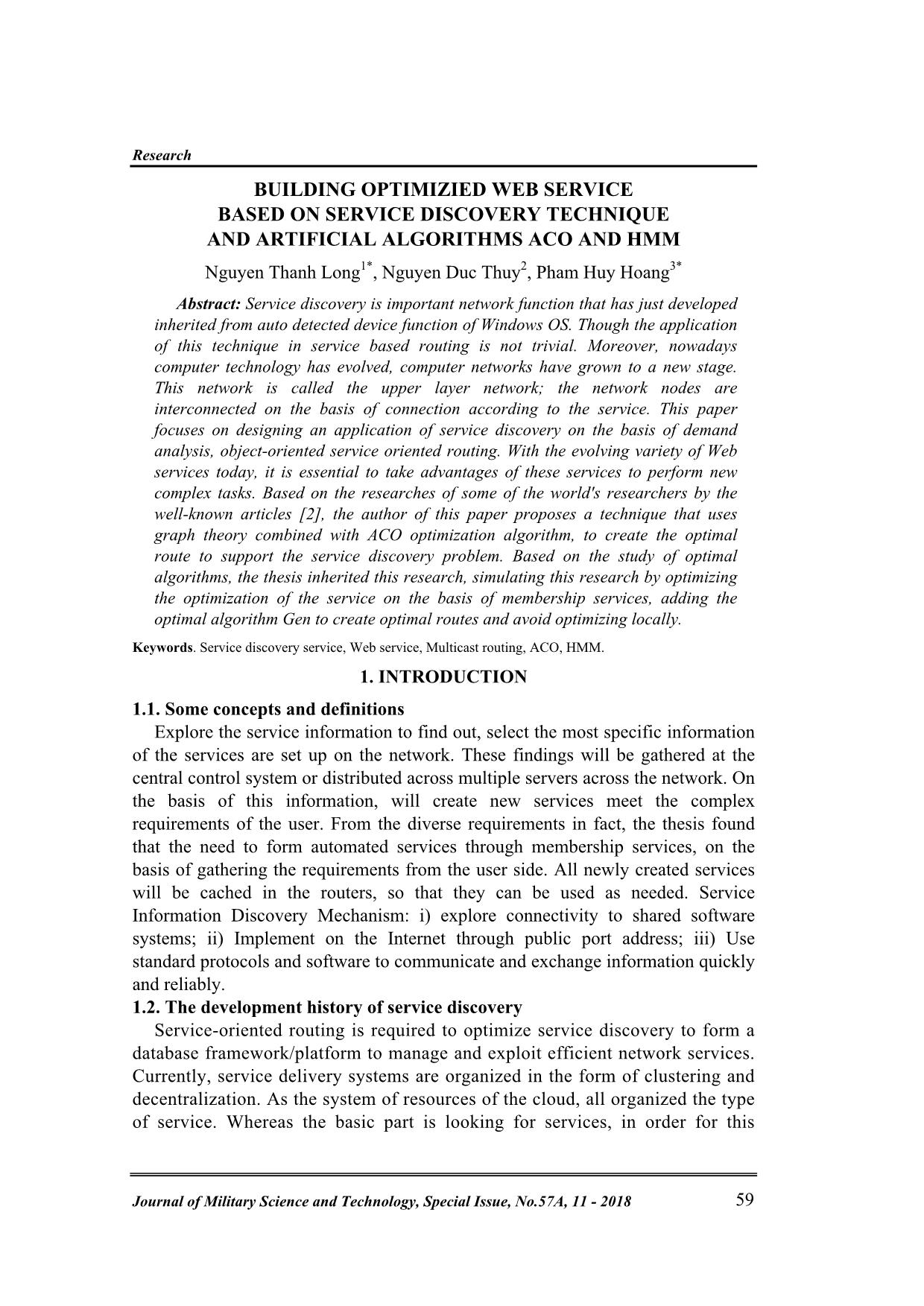
Trang 1
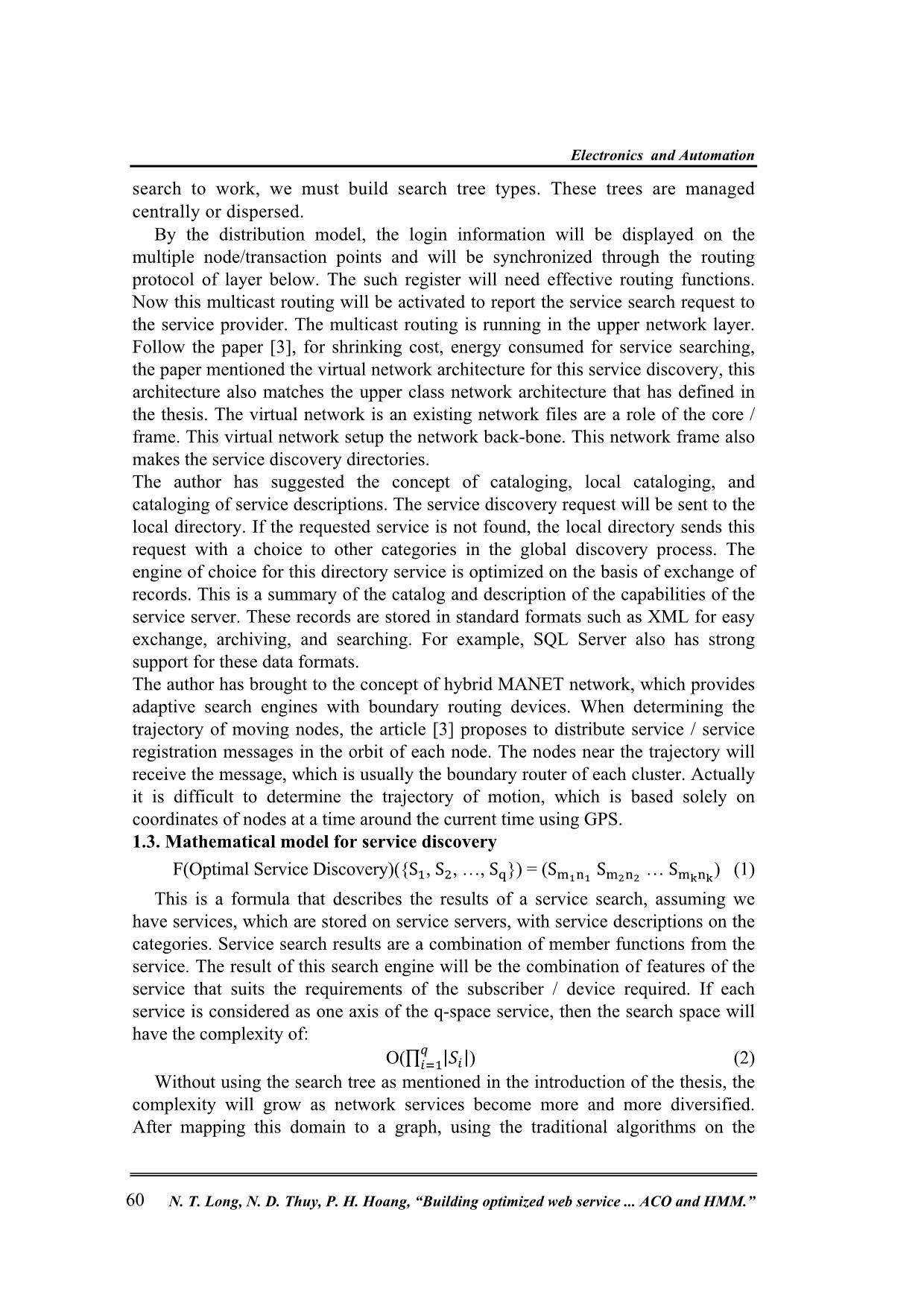
Trang 2
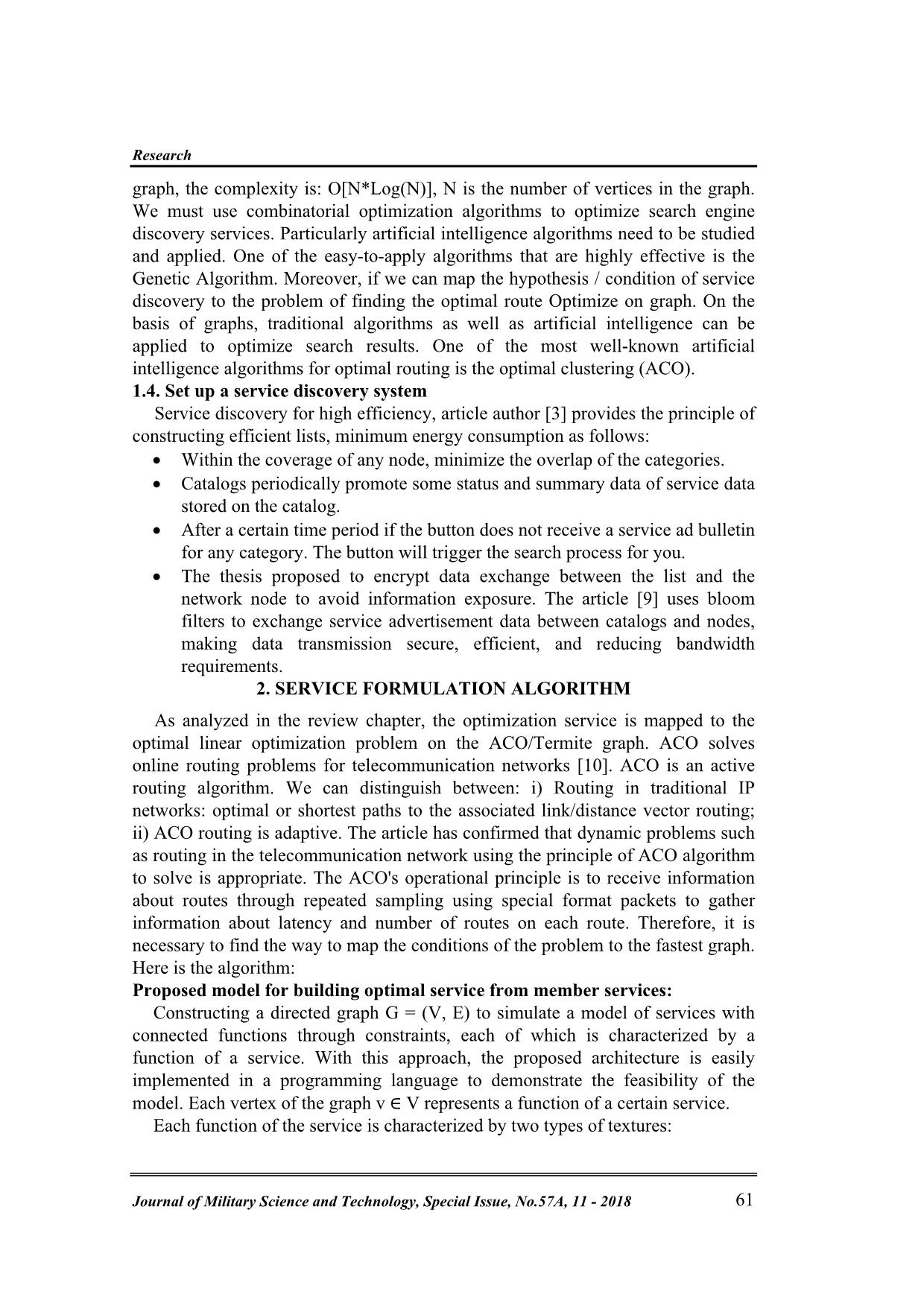
Trang 3
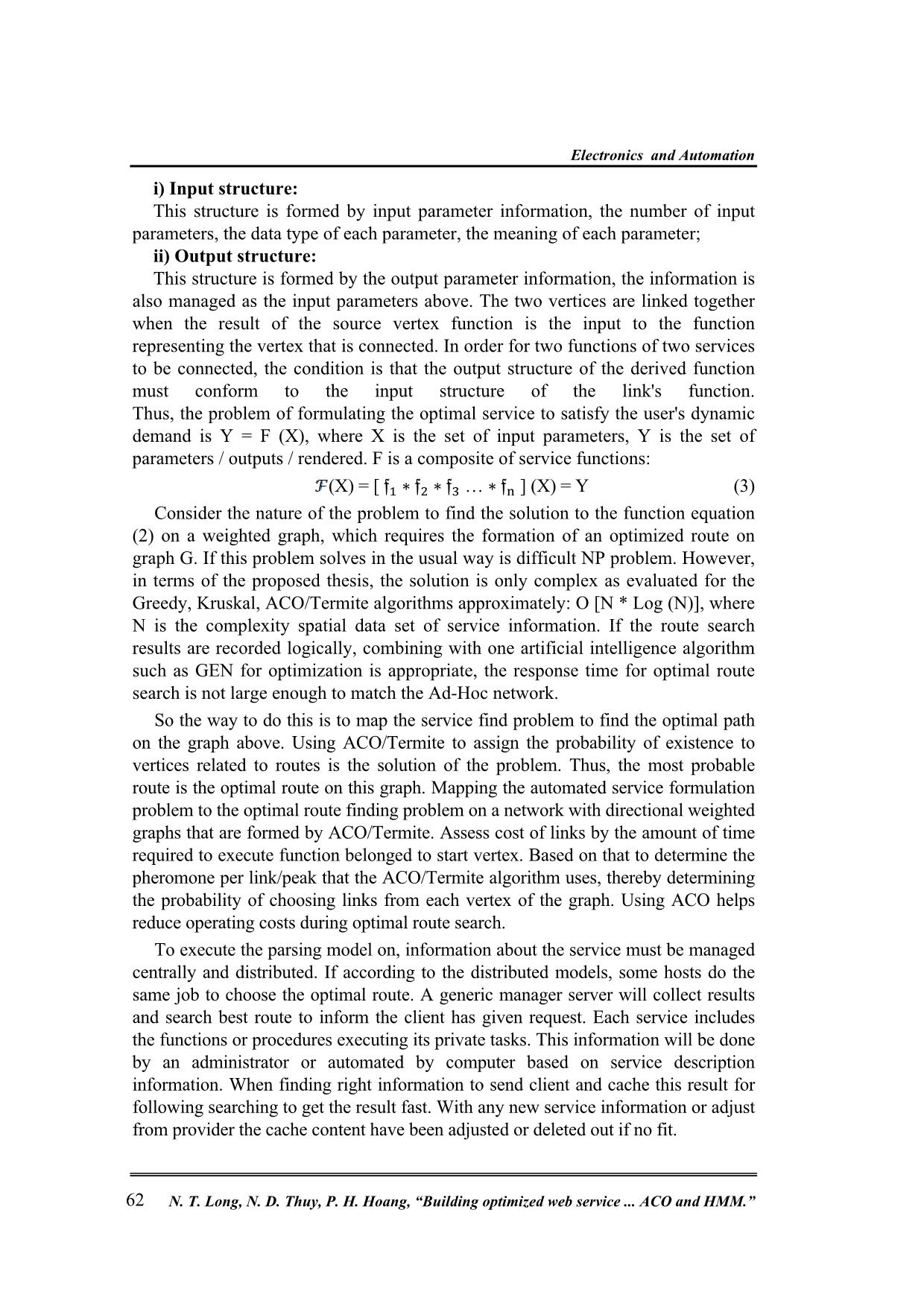
Trang 4
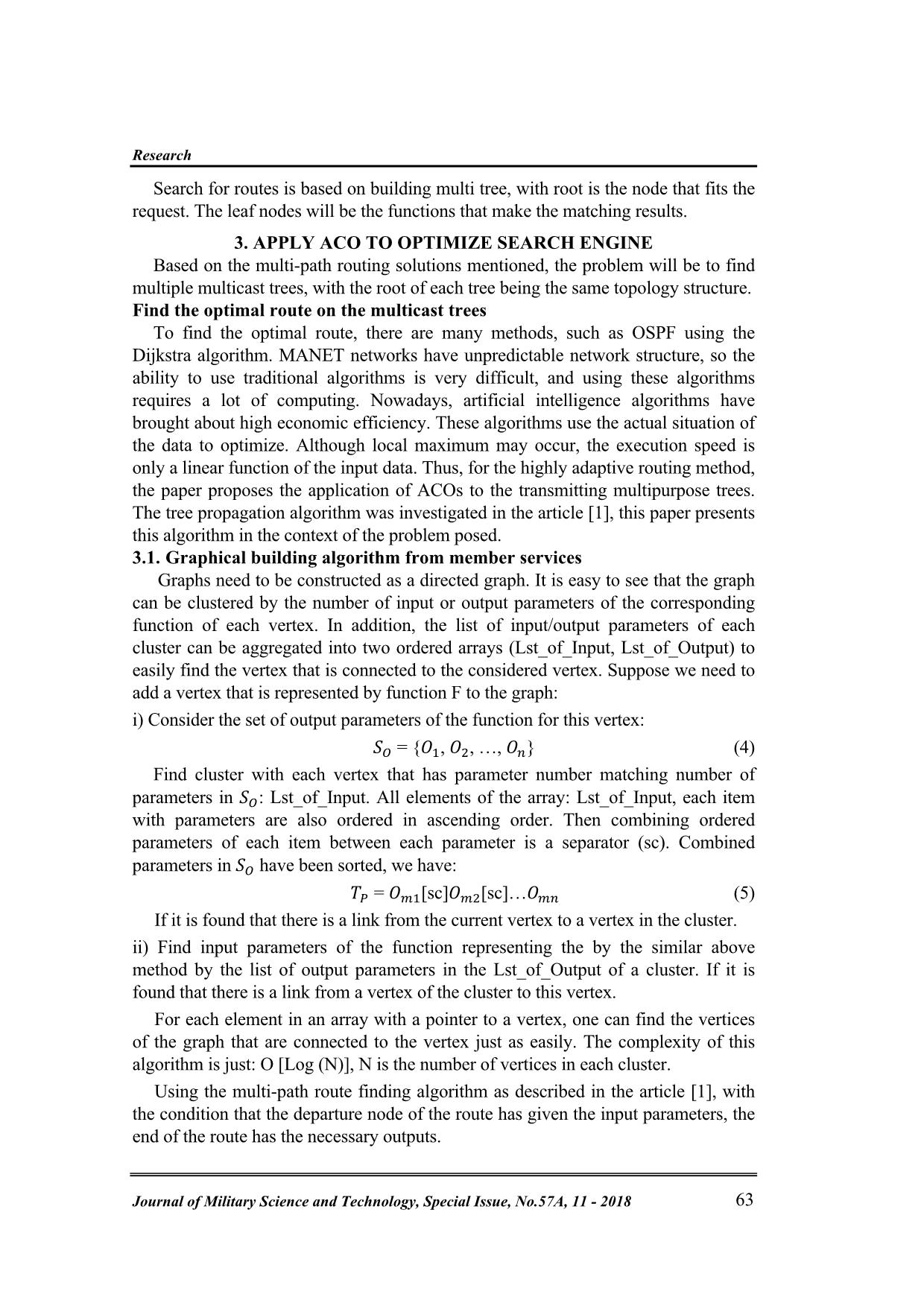
Trang 5
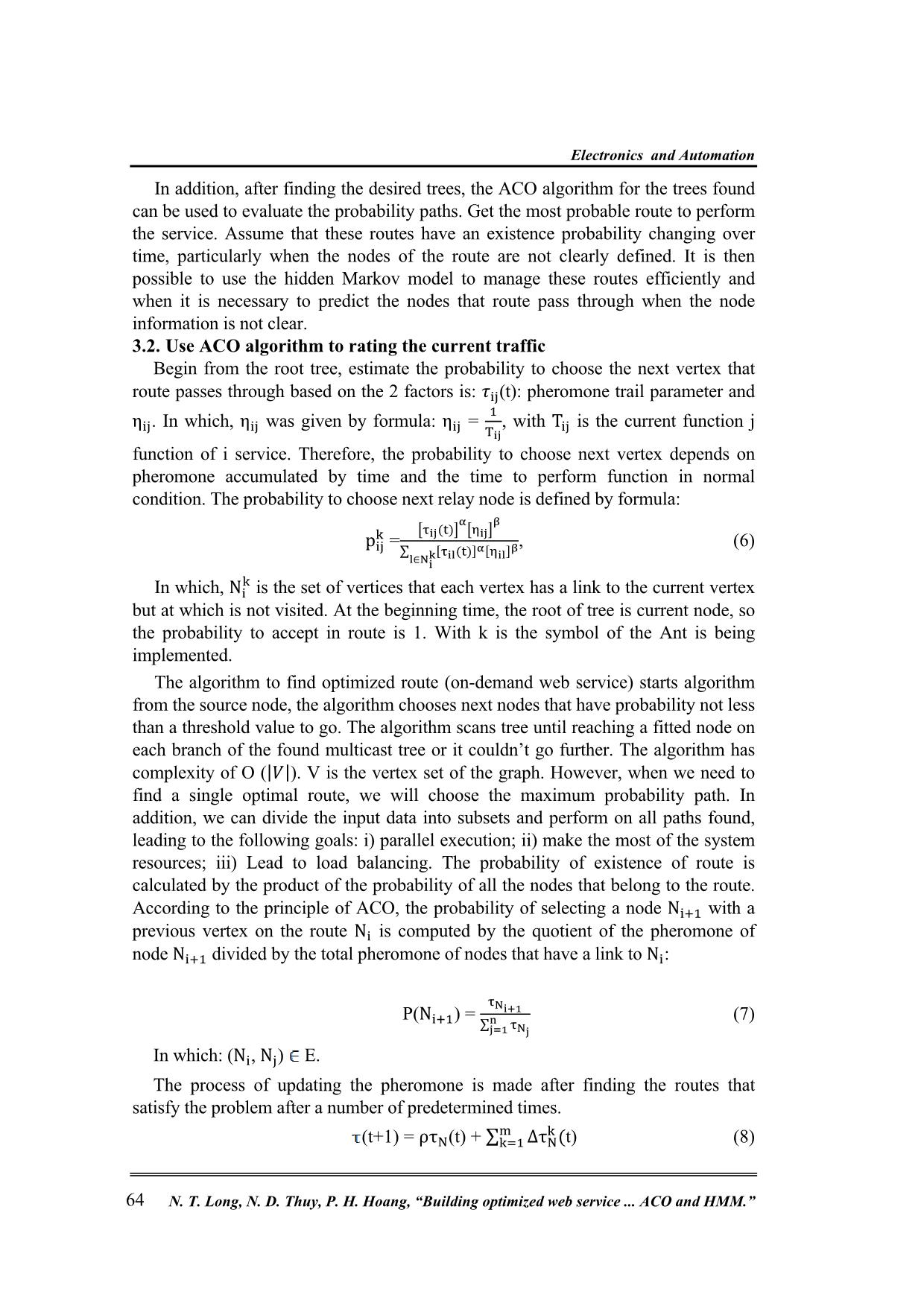
Trang 6
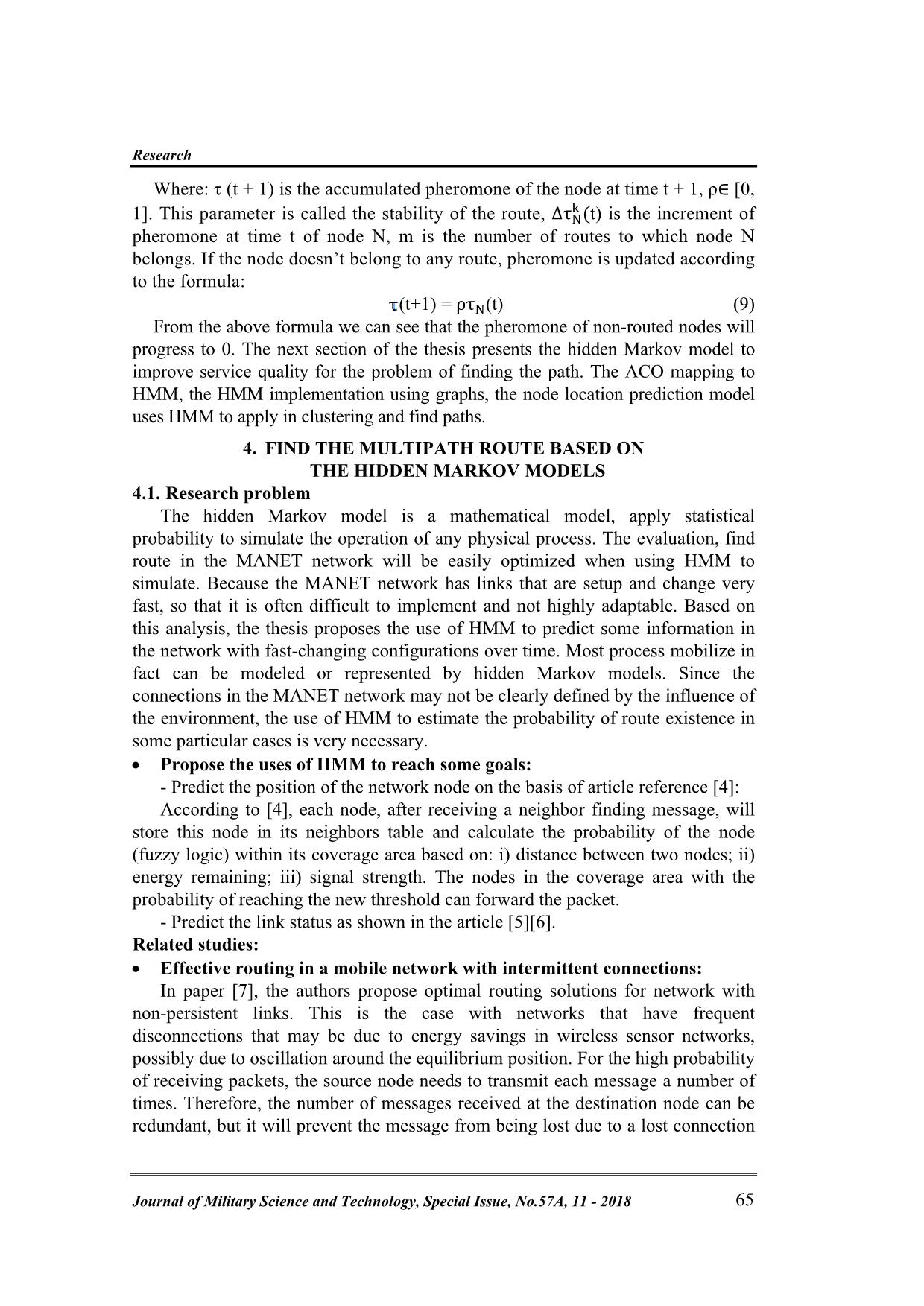
Trang 7
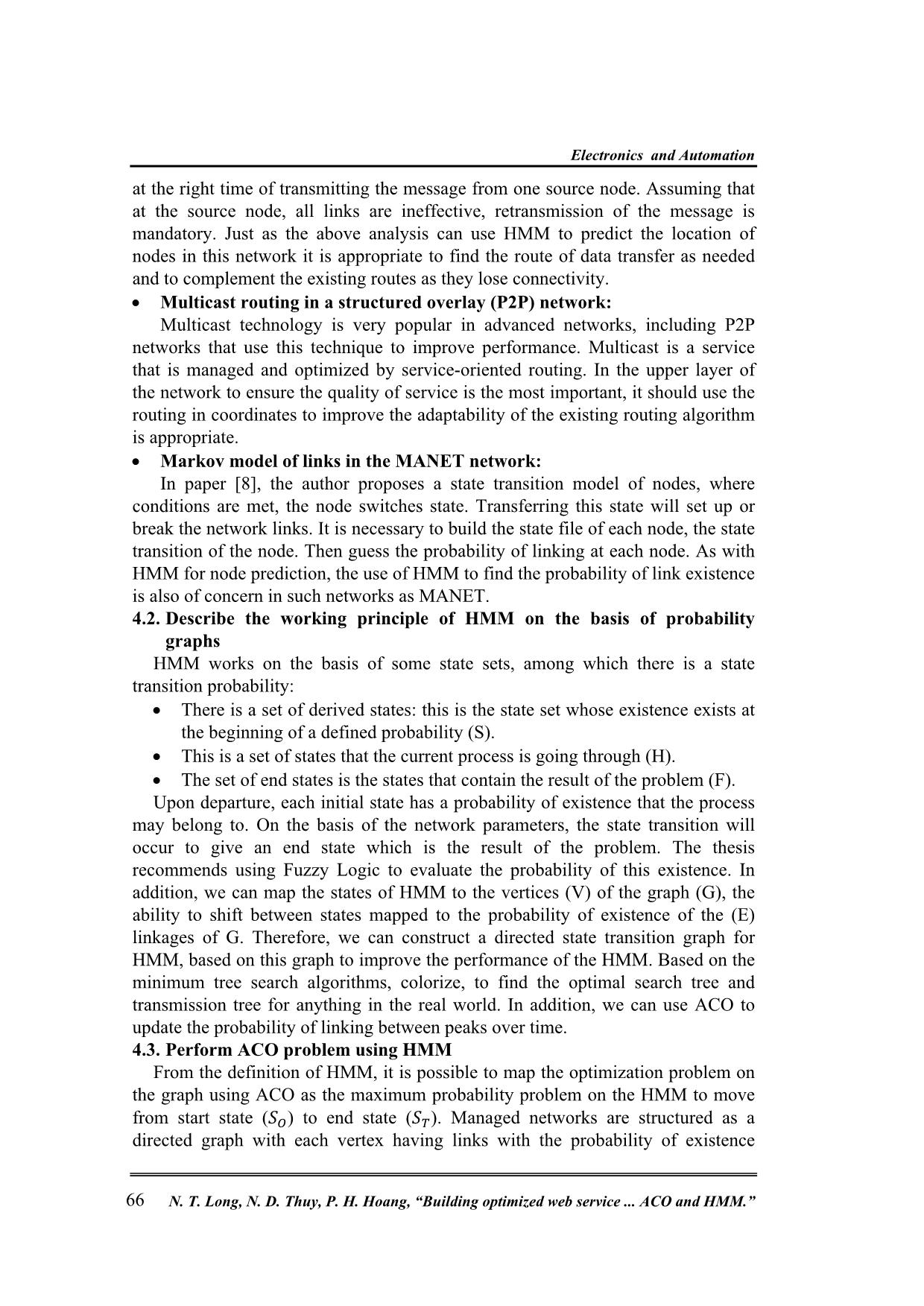
Trang 8
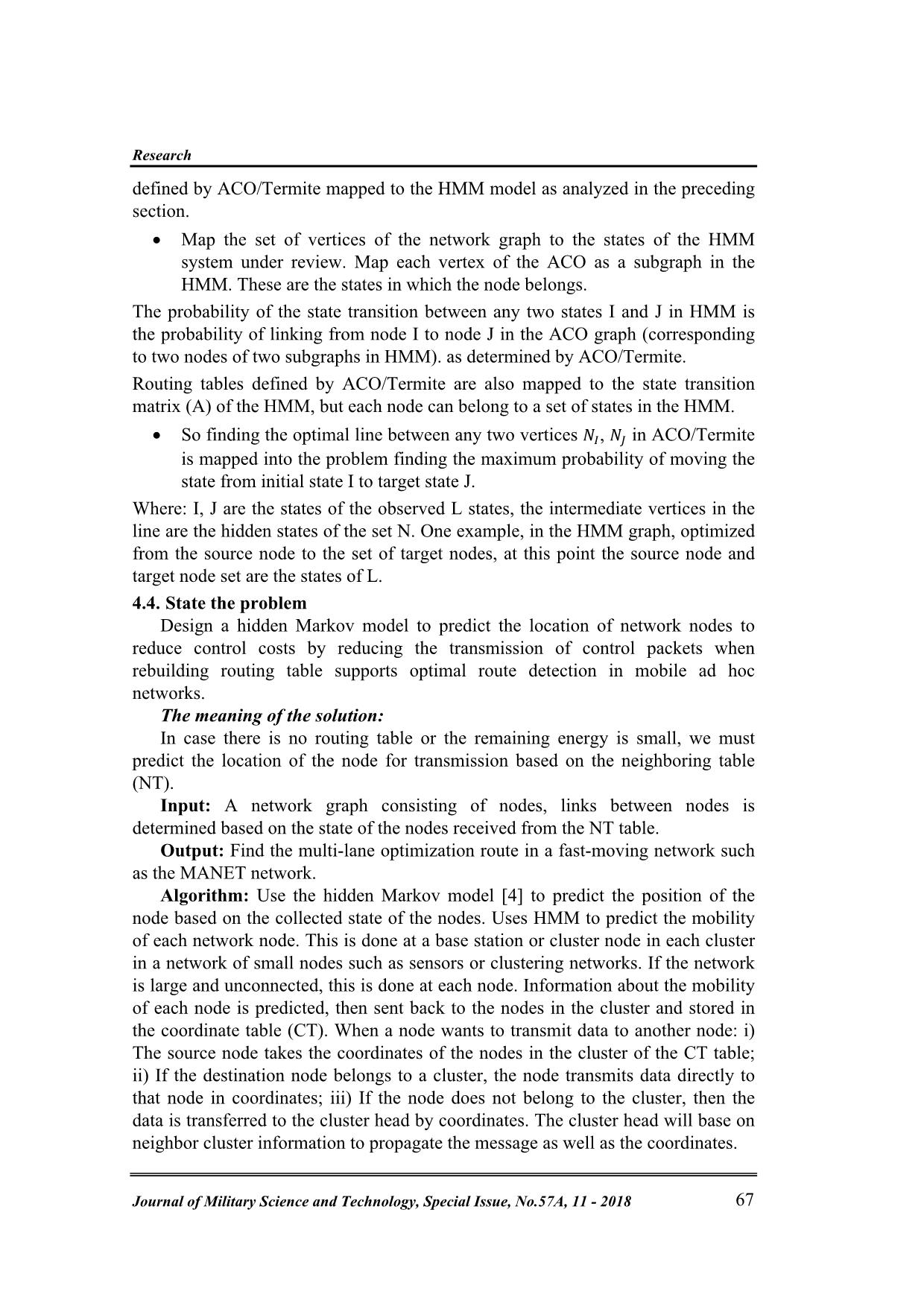
Trang 9
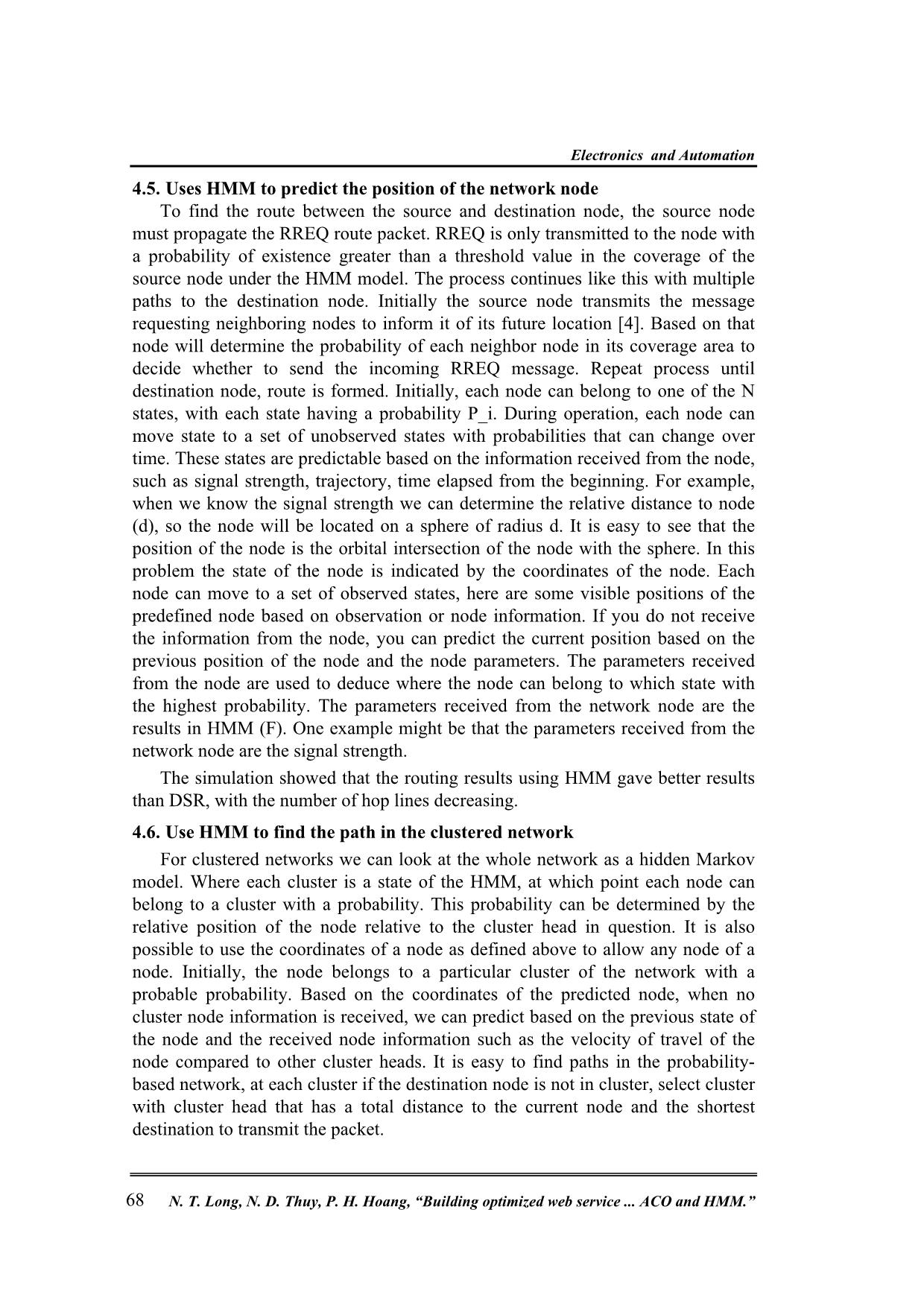
Trang 10
Tải về để xem bản đầy đủ
Tóm tắt nội dung tài liệu: Building optimizied web service based on service discovery technique and artificial algorithms aco and HMM

onditions are met, the node switches state. Transferring this state will set up or break the network links. It is necessary to build the state file of each node, the state transition of the node. Then guess the probability of linking at each node. As with HMM for node prediction, the use of HMM to find the probability of link existence is also of concern in such networks as MANET. 4.2. Describe the working principle of HMM on the basis of probability graphs HMM works on the basis of some state sets, among which there is a state transition probability: There is a set of derived states: this is the state set whose existence exists at the beginning of a defined probability (S). This is a set of states that the current process is going through (H). The set of end states is the states that contain the result of the problem (F). Upon departure, each initial state has a probability of existence that the process may belong to. On the basis of the network parameters, the state transition will occur to give an end state which is the result of the problem. The thesis recommends using Fuzzy Logic to evaluate the probability of this existence. In addition, we can map the states of HMM to the vertices (V) of the graph (G), the ability to shift between states mapped to the probability of existence of the (E) linkages of G. Therefore, we can construct a directed state transition graph for HMM, based on this graph to improve the performance of the HMM. Based on the minimum tree search algorithms, colorize, to find the optimal search tree and transmission tree for anything in the real world. In addition, we can use ACO to update the probability of linking between peaks over time. 4.3. Perform ACO problem using HMM From the definition of HMM, it is possible to map the optimization problem on the graph using ACO as the maximum probability problem on the HMM to move from start state (��) to end state (��). Managed networks are structured as a directed graph with each vertex having links with the probability of existence Research Journal of Military Science and Technology, Special Issue, No.57A, 11 - 2018 67 defined by ACO/Termite mapped to the HMM model as analyzed in the preceding section. Map the set of vertices of the network graph to the states of the HMM system under review. Map each vertex of the ACO as a subgraph in the HMM. These are the states in which the node belongs. The probability of the state transition between any two states I and J in HMM is the probability of linking from node I to node J in the ACO graph (corresponding to two nodes of two subgraphs in HMM). as determined by ACO/Termite. Routing tables defined by ACO/Termite are also mapped to the state transition matrix (A) of the HMM, but each node can belong to a set of states in the HMM. So finding the optimal line between any two vertices ��, �� in ACO/Termite is mapped into the problem finding the maximum probability of moving the state from initial state I to target state J. Where: I, J are the states of the observed L states, the intermediate vertices in the line are the hidden states of the set N. One example, in the HMM graph, optimized from the source node to the set of target nodes, at this point the source node and target node set are the states of L. 4.4. State the problem Design a hidden Markov model to predict the location of network nodes to reduce control costs by reducing the transmission of control packets when rebuilding routing table supports optimal route detection in mobile ad hoc networks. The meaning of the solution: In case there is no routing table or the remaining energy is small, we must predict the location of the node for transmission based on the neighboring table (NT). Input: A network graph consisting of nodes, links between nodes is determined based on the state of the nodes received from the NT table. Output: Find the multi-lane optimization route in a fast-moving network such as the MANET network. Algorithm: Use the hidden Markov model [4] to predict the position of the node based on the collected state of the nodes. Uses HMM to predict the mobility of each network node. This is done at a base station or cluster node in each cluster in a network of small nodes such as sensors or clustering networks. If the network is large and unconnected, this is done at each node. Information about the mobility of each node is predicted, then sent back to the nodes in the cluster and stored in the coordinate table (CT). When a node wants to transmit data to another node: i) The source node takes the coordinates of the nodes in the cluster of the CT table; ii) If the destination node belongs to a cluster, the node transmits data directly to that node in coordinates; iii) If the node does not belong to the cluster, then the data is transferred to the cluster head by coordinates. The cluster head will base on neighbor cluster information to propagate the message as well as the coordinates. Electronics and Automation N. T. Long, N. D. Thuy, P. H. Hoang, “Building optimized web service ... ACO and HMM.” 68 4.5. Uses HMM to predict the position of the network node To find the route between the source and destination node, the source node must propagate the RREQ route packet. RREQ is only transmitted to the node with a probability of existence greater than a threshold value in the coverage of the source node under the HMM model. The process continues like this with multiple paths to the destination node. Initially the source node transmits the message requesting neighboring nodes to inform it of its future location [4]. Based on that node will determine the probability of each neighbor node in its coverage area to decide whether to send the incoming RREQ message. Repeat process until destination node, route is formed. Initially, each node can belong to one of the N states, with each state having a probability P_i. During operation, each node can move state to a set of unobserved states with probabilities that can change over time. These states are predictable based on the information received from the node, such as signal strength, trajectory, time elapsed from the beginning. For example, when we know the signal strength we can determine the relative distance to node (d), so the node will be located on a sphere of radius d. It is easy to see that the position of the node is the orbital intersection of the node with the sphere. In this problem the state of the node is indicated by the coordinates of the node. Each node can move to a set of observed states, here are some visible positions of the predefined node based on observation or node information. If you do not receive the information from the node, you can predict the current position based on the previous position of the node and the node parameters. The parameters received from the node are used to deduce where the node can belong to which state with the highest probability. The parameters received from the network node are the results in HMM (F). One example might be that the parameters received from the network node are the signal strength. The simulation showed that the routing results using HMM gave better results than DSR, with the number of hop lines decreasing. 4.6. Use HMM to find the path in the clustered network For clustered networks we can look at the whole network as a hidden Markov model. Where each cluster is a state of the HMM, at which point each node can belong to a cluster with a probability. This probability can be determined by the relative position of the node relative to the cluster head in question. It is also possible to use the coordinates of a node as defined above to allow any node of a node. Initially, the node belongs to a particular cluster of the network with a probable probability. Based on the coordinates of the predicted node, when no cluster node information is received, we can predict based on the previous state of the node and the received node information such as the velocity of travel of the node compared to other cluster heads. It is easy to find paths in the probability- based network, at each cluster if the destination node is not in cluster, select cluster with cluster head that has a total distance to the current node and the shortest destination to transmit the packet. Research Journal of and in the previous service orientation. Graphs are built on the basis of the structure of the functions and procedures of Web services that can be run independently before performing the tree search algorithm. Using the ACO algorithm to evaluate the optimal route selection probability that is performed over a given time period, or where the route meets certain criteria. In the future, the author will stu the basis of adaptive routing in conjunction with artificial intelligence algorithms. The simulation is written in C# programming language, the input of the system is a number of real Web s production and business at the work unit of the author. The simulation of the Web service setup was conducted a number of times, measuring the time taken to graph the results. Finding the lines satisfy the ACO algorithm to find the probability of each route being selected. From the find paths with probability, choose the best path that has the highest probability of creating a Web service. As a result of th perform all t_All jobs and the optimal route search, the generated Web service was created with the request being passed through the t_Ex interface to the file. Logs and graphs show the time variability of the algori Each time the implementation is reported results on the program interface: Fig search, service implementation) with time (find optimal is quite stable over time and the ratio of time Use the graph to find the broadcast multiples mentioned in the previous section Looking at the graph above, we find the optimal route and service performance ure Military 1. Comparison of Y z dy additional optimization algorithms to find the optimal route on Science and Technology, Special I 5. SIMULATIO y ervices, so simulation results can be used to recover. -axis execution time (graph generation, optimal route axis) self ing the problem from the graph is formed, using N AND ASSESSMENT -service motion. e simulation program, the time taken to ssue, No.57 ���� ��� varies in a relatively stable range. thm in some implementations. A, route, implementation) (X 11 x - 201 8 69 - Electronics and Automation N. T. Long, N. D. Thuy, P. H. Hoang, “Building optimized web service ... ACO and HMM.” 70 6. CONCLUSIONS Service discovery is an important function in the upper layer network, so that this function works optimally, especially in order to reduce energy consumption and network control costs. The thesis proposed a solution for intelligent network segmentation, multi-path routing, and multiplexing, to enable this function to be effective. Map the problem finds efficient, optimal optimization problem to find multi-line route, optimization on the graph, to ease the use of search trees, reduce costs. On the other hand, this method makes it easy to use the ACO algorithm to optimize and evaluate the probability of existence. REFERENCES [1]. Nguyen Thanh Long, Nguyen Duc Thuy, Pham Huy Hoang, “Building Multiple Multicast Trees with Guarranteed QOS for Service Based Routing Using Artificial Algorithms”. Springer, ISBN: 978-3-319-29235-9, ICCASA 2015, LNICST 165, pp. 354–369, 2016. [2]. Sami Zhioua (2013): “Tor traffic analysis using Hidden Markov Models”, Security Comm. Networks 2013; 6:1075–1086. [3]. B.G.Obulla Reddy, Maligela Ussenaiah, Rayalaseema (2012): “An Adaptive Fuzzy Clustering and Location Management inMobile Ad Hoc Networks”. International Journal of Computer Applications & Information Technology Vol. I, Issue III (ISSN: 2278-7720). [4]. R. Nagwani, D. S. Tomar (2012): “Mobility Prediction based Routing in Mobile Adhoc Network using Hidden Markov Model”. International Journal of Computer Applications (0975 – 8887), Vol. 59– No.1. [5]. Seok K. Hwang, Dongsoo S. Kim (2007): “Markov model of link connectivity in mobile ad hoc networks”. Telecommun Syst (2007) 34:51–58. [6]. Amardeep Sathyanarayana, Pınar Boyraz, John H.L. Hansen (2008): “Driver Behavior Analysis and Route Recognition by Hidden Markov Models”. Proceedings of the 2008 IEEE International Conference on Vehicular Electronics and Safety, Columbus, OH, USA. [7]. R.Sharma, D. K. Lobiyal (2015): “Proficiency Analysis of AODV, DSR and TORA Ad-hoc Routing Protocols for Energy Holes Problem in Wireless Sensor Networks”. 3rd Inter. Conference on Recent Trends in Computing. [8]. Jaspreet Kaur, Dinesh Kumar, Giani Zial Singh (2017): “Distributed Hash Table based Routing for P2P Data sharing in MANETs”, e-ISSN: 2454-6615, WWJMRD 2017; 3(7): 82-85. [9]. Franc¸oise Sailhan, Val´ erie Issarny (2009): “Scalable Service Discovery for MANET”. HAL Id: inria-00414946. [10]. Gianni Di Caro (2004): “Ant Colony Optimization and its Application to Adaptive Routing in Telecommunication Networks”. PROMOTEUR: PROF. MARCO DORIGO, ANNEE ACAD´ EMIQUE´ 2003-2004. Research Journal of Military Science and Technology, Special Issue, No.57A, 11 - 2018 71 TÓM TẮT XÂY DỰNG MÔ HÌNH DỊCH VỤ WEB TỐI ƯU TRÊN CƠ SỞ KỸ THUẬT KHÁM PHÁ DỊCH VỤ VÀ CÁC THUẬT TOÁN TRÍ TUỆ NHÂN TẠO Khám phá dịch vụ là một chức năng mạng mới phát triển từ chức năng khám phá thiết bị trong hệ điều hành đã có trước đây. Nhưng việc áp dụng hiệu quả kỹ thuật này trong định tuyến hướng dịch vụ là một việc không tầm thường. Hơn thế nữa ngày nay, công nghệ điện toán phát triển, mạng máy tính đã phát triển đến một giai đoạn mới. Thế hệ mạng này gọi là mạng lớp trên, các nút mạng liên kết với nhau trên cơ sở kết nối theo dịch vụ. Trong bài báo này, chúng tôi đề xuất một kỹ thuật sử dụng lý thuyết đồ thị kết hợp với thuật toán tối ưu ACO, để tạo ra tuyến tối ưu hỗ trợ bài toán khám phá dịch vụ. Trên cơ sở nghiên cứu các thuật toán tối ưu, chúng tôi đã kế thừa nghiên cứu này, mô phỏng nghiên cứu này bằng bài toán hình thành dịch vụ tối ưu trên cơ sở các dịch vụ thành viên, bổ sung thêm thuật toán tối ưu Gen để tạo ra các tuyến tối ưu nhanh và tránh được tối ưu cục bộ. Từ khóa: Service discovery service, Web service, Multicast routing, ACO, HMM. Received 27th June 2018 Revised 10th October2018 Accepted 27th October 2018 Author affiliations: 1Trung tâm Công nghệ thông tin, Viễn Thông Hà Nội; 2Viện kỹ thuật Bưu điện, Học Viện Bưu chính Viễn thông; 3Viện Công nghệ thông tin, Đại học Bách khoa Hà Nội. *Email: ntlptpm1@yahoo.com, hoangph@soict.hut.edu.vn.
File đính kèm:
 building_optimizied_web_service_based_on_service_discovery_t.pdf
building_optimizied_web_service_based_on_service_discovery_t.pdf

